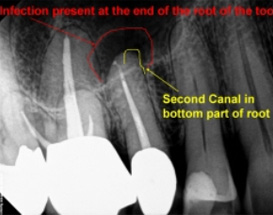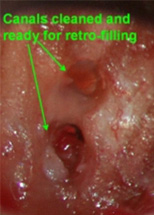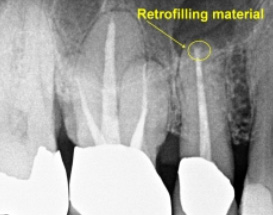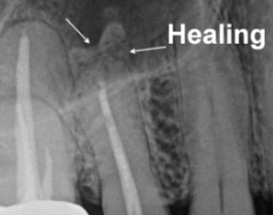In such cases, endodontic microsurgery may be necessary. Apicoectomy and root-end resection are old terms that no longer accurately describe modern endodontic microsurgery. Recent advances such as the digital operating microscope, surgical ultra-sonic tips, and new materials (i.e. ProRoot MTA by DENTSPLY) have transformed endodontic microsurgery. Modern endodontic microsurgery enables endodontists save more teeth with more confidence and minimal post-appointment discomfort. If you are told a root canal treatment is 'failing' and the tooth needs extraction ask if an endodontist could save the tooth with either retreatment or endodontic microsurgery.
As a matter of routine, a pathology report is provided for every surgeryThe findings of the pathology report are shared with both you and your dentist. During endodontic microsurgery the end of the canal is cleaned and sealed. During surgery the roots are inspected for cracks, fractures, and defects. The surrounding soft tissue and bone may be augmented to help improve the stability and aesthetics of the tooth.
Endodontic microsurgery is almost exclusively performed by endodontistsAs with all endodontic procedures at the Richmond Endodontic Centre adequate local anaesthetic (freezing) is provided. You will not feel pain during surgery. In addition, both oral and IV sedation are possible options to alleviate any stress and anxiety.
It is normal to have some swelling, tenderness, and occasionally some bruising after the surgery. Most people can expect to return to their normal activities the next day. For more information about pre- and post- surgical instructions please have a look at the microsurgical information package.
Below is an example of a surgery performed by Dr. Fransen at the Richmond Endodontic Centre. A year prior coming to our office, this gentleman had a root canal and new crown by his dentist. He was referred for an evaluation of recently developed bite sensitivity on the tooth. After considering the pros and cons of various treatment options, endodontic microsurgery was performed.
 |
 |
Near the end of the root, a second untreated canal splits from the main canal. Bacteria in this canal are responsible for the infection and subsequent bite sensitivity. |
One canal is sealed; the unfilled canal is full of dëbris and bacteria. This picture was taken via the digital operating microscope at the Richmond Endodontic Centre. |
 |
 |
Both canals were cleaned and shaped; they unite a few millimetres further up the root. |
A retro-filling was placed to seal the end of the root and promote healing. The bite sensitivity resolved within a few days. |
 |
One year recall, the tooth remains asymptomatic and functional. The lesion at the end of the root is healing and healthy bone is growing back around the end of the root. |
No matter how effective modern tooth replacements are, and they can be very effective, nothing is as good as a natural tooth
More Endodontics | Symptons →








